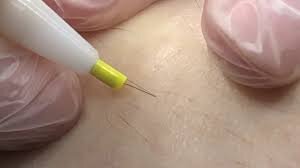
What is electrolysis?
Electrolysis is a method of removing individual hairs from the body permanently. Regardless of the cause - heredity, metabolic or hormonal conditions - electrolysis will permanently remove unwanted hair to reveal a glowing, confident you.
How does electrolysis work?
A professional electrologist inserts a very fine probe {usually the size of the hair being treated} into the natural opening of the hair follicle alongside the hair shaft. A tiny amount of electrical current is then applied to create a chemical or heat energy reaction to destroy the hair growth cells.
Why should I choose electrolysis over other temporary hair removal methods like waxing and laser?
Electrolysis is the only true permanent hair removal method and the only permanent treatment recognized by the FDA
Unlike other hair removal options, professionally performed electrolysis eliminates unwanted hair, permanently, with unsurpassed results. Moreover, it does so for the largest variety of skin and hair types.
Laser promoters compare laser to electrolysis, although laser assisted hair removal is considered a temporary method. It has not been evaluated for long-term safety of the patient’s skin and health.
Waxing, threading and tweezing are alike. However, ingrown hairs and discoloration may result. Additionally, they may cause an increase in hair growth activity. Depilatories and Shaving can cause an irritation to the skin while the hair regrows quickly. These methods can require a lifetime of maintenance. Many can appear inexpensive but cost more due to long term use and are found to be inconvenient.
Electrolysis works on most areas of the body to give you smooth, sleek healthy looking skin. No other solution claims such universal acceptability and success.
What are modalities?
Medical electrolysis devices can destroy the hair growth cells with chemical energy, heat energy, or both. The method chosen by the electrologist is called the modality. There are three modalities in current use:
Galvanic is a chemical process. A DC (direct current) passes through the needle charging the moisture (H2O) and salt (NaCl) naturally found in the follicle causing a chemical reaction. This chemical reaction produces sodium hydroxide (lye). The lye destroys the hair follicle by chemical decomposition.
Thermolysis produces heat (aka short-wave). The AC (alternating current) passing through the probe causes vibration in the water molecules surrounding the hair follicle, which produces heat that destroys the hair growth cells in the follicle. A higher intensity current can be applied for less time in the follicle, or current can be used at lower intensity with longer timing.
The Blend Method combines the benefits of galvanic current with thermolysis current. A DC current is passed through the probe, producing lye, which is then heated up by the AC current. The heat spreads the lye around the follicle, ensuring proper damage to the hair follicle tissue. This is faster than Galvanic alone, but still more time consuming than Thermolysis. This combination has been found to be more effective in the rate of hair destruction over time.
All three modalities are effective and the electrologist usually selects the one with which they are most familiar. However, an electrologist who is used to working with Thermolysis may choose to use Blend or Galvanic if their client has coarse, curly, or wavy hairs and or a low-pain threshold when receiving Thermolysis alone.
Source: American Electrology Association + Zap Electrolysis
Do electrologists follow appropriate infection prevention procedures?
The American Electrology Association has written Standards for Infection Prevention following the most recent recommendations from the Center for Disease Control (CDC), the Occupational Safety and Health Administration (OSHA), and the Association for Practitioners in Infection Control and Epidemiology (APIC). Your electrologist can also have additional training in Barbicide Infection Control and Covid-19 certifications
Will my hair ever grow back after electrolysis?
Electrolysis is the ONLY FDA APPROVED method for PERMANENT HAIR REMOVAL, which means your hair will not grow back after the completion of your treatment plan.
The following hair removal methods are not legally allowed to claim permanent results. (Laser can only guarantee “hair reduction”)
Laser (Hair regrowth rates vary from person-to-person)
Epilating (Lasts 1-3 weeks)
Waxing (Lasts 2-3 weeks)
Tweezing (Lasts 2-3 weeks)
Shaving (Lasts 1-3 days)
Threading (Lasts 1-3 weeks)
Sugaring (Lasts 2-3 weeks)
Depilatory Creams (Lasts 1-3 days)
How many treatments will I need?
Everyone’s hair removal story is unique because there are many factors influencing your success rate including:
Hair Density & Texture
Hair Growth Phase
Pain Threshold
Hydration
Machine Settings
Skin Sensitivity Characteristics
Other Hair Removal Methods
Medications
Your electrologist will design a treatment plan for you depending on these factors and if you follow it, your hair should be gone for good in 12-24 months. It's important to remember not to compare your progress with others, because this can discourage you and diminish your own success metrics without the consideration of how everyone responds differently under different conditions.
Is electrolysis safe?
Electrolysis is safe for all skin and hair types, and for people of all ages and ethnicities. It’s even safe for tattoos. However, it is important to alert your electrolysis of all current and past health conditions because special attention must be paid to some including, but not limited to: diabetes, pregnancy », pacemakers, and allergies to certain metals, latex and medications ». Remember, it’s important to be completely honest when completing health forms whether visiting a medical provider or esthetician.
Can I wax between electrolysis treatments?
NO! Waxing, tweezing, threading and sugaring are highly discouraged because they not only cause ingrown hairs, but they also they rip the hair from the root.
When hair is pulled from the root, the body classifies it as an injury and immediately kicks into protect and repair mode triggering all the body functions necessary to repair the area and regrow the hair. As a result, the hair most likely would not have grown long enough to treat effectively by the next time you visit your electrologist because an electrologist can’t remove what they can’t see. The body's repairing process also triggers thicker, deeper hair growth making it harder to destroy the entire follicle in a single session, thus slowing down the electrolysis process.
Instead, try shaving, clipping, bleaching, or depilatories between appointments, but remember to allow enough time for the hair to grow long enough so your electrologist can see it.
Does electrolysis hurt?
Electrolysis treatments sting, but individual tolerances vary greatly. Even the most sensitive person should be able to tolerate the treatments. The sting from treatment is quick, and then it's over. Many options are available for topical numbing cremes to lessing the feeling
Can you tell me more about the “needle” you use?
Electrologists do not use a needle. They use what is called a probe. A needle is hollow inside in order to allow blood to transfer from the body and therefore must be larger in diameter than a probe. A probe is only as large as the size of the hair it’s removing and is significantly shorter than a needle because it only needs to penetrate the skin, never beyond it.
Does electrolysis leave a scar?
There is a small risk of scarring when administering an electrical current though a probe inserted in the skin. This is why it is important to go to a licensed and or certified professional electrologist who knows how to select the best modality for your hair type, select the proper machine settings, make an accurate insertion, and knows how to prevent over-treatment and hyper-pigmentation. It is also important to be honest on your health assessment form, especially if you're prone to conditions like keloids.
Is electrolysis safe for tattoos?
Absolutely! In fact, many clients with tattoos who get laser treatments go to an electrologist to remove the hair covering their tattoo because a laser would otherwise burn the skin.
Can I get electrolysis if I am pregnant?
Unwanted hair can be caused by hormonal changes brought on by pregnancy. Electrolysis can be performed on any normal skin. This includes pregnant women. We suggest that you seek the advice of your physician before beginning treatment.
How can I learn more about permanent hair removal?
Your electrologist will be able to answer your hair removal questions at your appointment or consultation.
Source: American Electrology Association.




